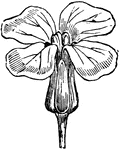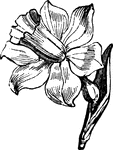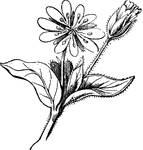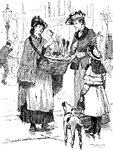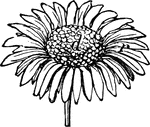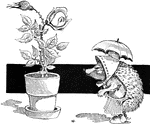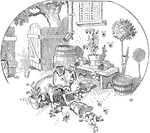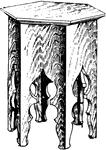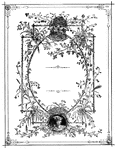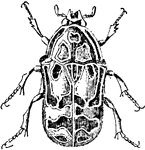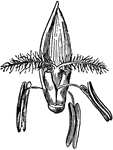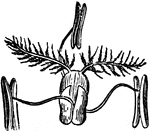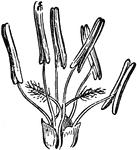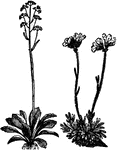
Saxifrage
An extensive genus of hardy perennial herbs, with alternate leaves and simple flower-stems. They are…
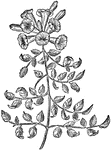
Trumpet Flower
The popular name of several flowering vines, which have a woody stem and bear flowers formed like a…
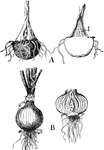
Onion
This illustration shows the shortened types of stems: A, corm of jack-in-the-pulpit. At left surface…

Angiosperm
This illustration shows the flower and sporophylls of Angiosperms: 1, flower of Sedum with leaf-like…
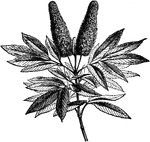
Cunonia
A small genus of plants. They are small trees or shrubs with compound leaves and dense racemes of small…
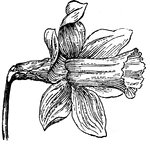
Daffodil Flower
Flowers of a bright primrose yellow color with a cylindrical crown larger then the funnel shaped tube.

Lentil
"An annual plant of the same genus with tares, a native of countries near the Mediterranean, and which…

Evening Primrose
"Evening Primrose: a, flower divested of calyx and corolla, to show the parts or fructification; b,…
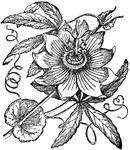
Passionflower
"A genus of plants almost exclusively native to the warm parts of America, and belonging to the natural…

Rose
"Proliferous or monstrous Rose, showing the prolongation of the axis beyond the flower. C, calyx transformed…
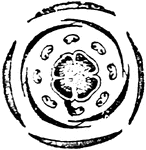
Heath
"Diagram of the flower of Heath (Erica), have four sepals, four divisions of the corolla, eight stamens…

Iris
"Diagram of the trimerous symmetrical flower of Iris. There are three alternating divisions of each…

Fritillary
"Diagram of the symmetrical trimerous flower of Fritillary, having three divisions of the two outer…
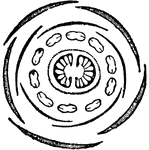
Saxifrage
"Diagram of the flower of Saxifrage (Saxifraga tridactylites). The calyx and corolla consist of five…

Sweet-pea
"Diagram of flower of Sweet-pea (Lathyrus), showing five parts of the calyx, of which two are superior,…

Pea
"Flower of the Pea (Pisum sativum), showing a papillionaceous corolla, with one petal superior, st,…

Purple Foxglove
A biennial herb native to Europe. Its leaves and flowers are poisonous to humans and some animals.
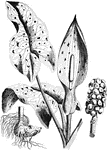
Cuckoo Pint
A common plant of the north temperate Europe. It has purple spotted leaves and can force people to have…
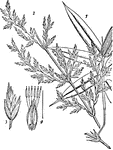
Indian Bamboo
"Bambusa arundinacea, in Indian bamboo. 1. Leafy shoot. 2, Branch of inflorescence. 3, Spikelet.…
Drag
"The drag is a useful, light three-pronged tool which may be used for loosening the soil amongst vegetable…

Flower Gatherer
"Selby's Flower Gatherer which cuts and holds the flower at the same time." — Encyclopedia Britannica,…
Sulphurator
"Sulphurators are instruments for distributing flowers of sulphur, for the purpose of destroying mildew.…

Epps's Sulphurator
"Sulphurators are instruments for distributing flowers of sulphur, for the purpose of destroying mildew.…

Allaria Officinalis
"Allaria officinalis. a, upper part of stem, with leaves and flowers; b, extremity of a branch, in fruit."…

Andromeda
"A genus of Andromeda polifolia of plants of the natural order Ericaceae, distinguished by a 5-valve…
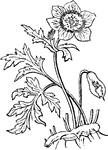
Anemone Coronaria
"A genus of plants of the natural order Ranunculaceae, having an involucre of three divided leaves,…

Arnica Montana
"A genus of plants belonging to the natural order compositae, sub-order Corymbiferae. The flowers of…

Arracacha
"A plant of the natural order Umbelliefrae, a native of the elevated table-lands in the neighborhood…
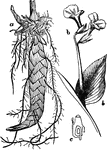
Arrow-root
"Arrow-root (M. arundinacea). a, tubers; b, leaf and flowers; c, stamen and style." — Chambers'…

Common Ash
"A genus of trees belonging to the natural order Oleaceae, and distinguished by very imperfect flowers,…

Common Ash
"Common Ash. a, a branch with leaves; b, flowers; c, fruit (on a considerably larger scale than the…
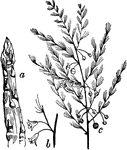
Asparagus
"Asparagus. a, a young shoot; b, flowers; c, the upper end of a stem, showing branches, leaves, and…

Auricula
"A plant of the same genus with the Primrose, much cultivated in flower-gardens. The Auricula has long…

Alfred's Jewel
"An ornament of gold, apparently intended to hang round the neck, found in Athelney, and now in the…

Balsam
"Balsam (Impatiens Noli-me-tangere). a, top of stem with leaves and flowers; b, ripe fruit unopened;…

Batatas
"A perennial plant with long creeping stems, heart-shaped leaves on long stalks, and variously lobed,…
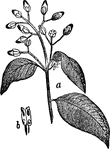
Cinnamon
"Cinnamon: a, end of branch, with leaves and flowers; b, four-celled anther." — Chambers' Encyclopedia,…
